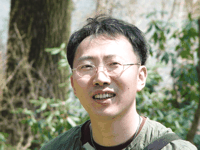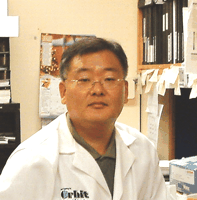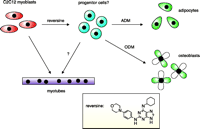Dedifferentiation? What’s next?
Stem cells have elicited a great deal of attention because of their enormous potential for tissue and cell replacement therapy. Although embryonic stem cells (ESC) can differentiate into many tissue types (i.e., pluripotent), direct injection of ESC into mice induces benign tumors (1). In contrast, partially committed adult stem cells (ASC) can only differentiate into certain lineages of cells (i.e., multipotent) without resultant tumor formation, thus having greater potential as therapeutic materials. Although the preparation of ESCs is a dramatic technical advancement––especially those recently derived from human sources (2)––the low number of extant ASCs within a very large mixed population of cells poses an even tougher challenge for collection and cultivation. To surmount these difficulties, one approach would be to selectively differentiate ESCs to specific ASCs; however, this would require a thorough understanding of the mechanisms regulating differentiation. Alternatively, dedifferentiation of somatic cells into ASC-like cells, followed by selective differentiation into another cell or tissue, offers another route. Becuase it is generally believed that differentiation is a unidirectional, nonreversible event, achieving dedifferentiation is a major challenge.
Modulating the differentiation of ESCs or ASCs by using small-molecule cocktails or by genetic modification has been demonstrated, but most efforts have been devoted to driving ESCs or ASCs down differentiation pathways by “natural” means, for example, through the use of growth factors. In this context, reversine, recently reported by Chen et al. (3) is a very interesting small molecule. The authors added reversine to myoblast C2C12 cells that otherwise differentiate into multinucleated myotubes. The reversine-treated cells became multipotent cells and could be redirected to differentiate into osteoblasts or adipocytes using a cell-specific differentiation cocktail: osteogenic differention medium (ODM; ascorbic acid-2-phosphate, dexamethasone, and β-glycerophosphate), or adipogenic differentiation medium [ADM; 3-isobutyl-1-methylxanthine, dexamethasone, and insulin or peroxisome proliferator–activated receptor gamma (PPARγ) agonist (personal communication with Sheng Ding, Scripps Institute)] (Figure 1⇓). These findings open up the possibility of a small-molecule treatment that changes one cell-type into another. The authors explain that the first step of reversine treatment induced “dedifferentiation” of the muscle committed C2C12 cells into multipotent progenitor cells. The dedifferentiation hypothesis can be one possible answer; however, other explanations could account for this phenomenon.
Although C2C12 cells are considered to be a myogenic lineage–committed cell line, it is known that treatment of C2C12 cells with bone morphogenic proteins (e.g., BMP-2) induces their transdifferentiation into osteoblasts (4), and transfection of C2C12 cells with a dominant-negative form of T cell factor 4 (TCF4, a transcription factor) converts C2C12 cells into adipocytes (5). It seems that C2C12 myoblasts have the potential to direct their differentiation to a variety of different cell types; this phenomenon has been explained as transdifferentiation, which might be a unique property of C2C12 cell lines in vitro, and might not necessarily be a property of the natural muscle cells as they exist in the body. According to the authors of the reversine study, C2C12 cells in growth media were treated with reversine for four days. Under the same conditions, the authors report that untreated (control) C2C12 cells started to express markers of differentiated muscle cells, which can be induced if cell growth becomes arrested because of contact inhibition or growth factor deprivation. Thus, the activity ascribed to reversine can also be explained if reversine inhibits the ability of C2C12 cells to differentiate into muscle––without inhibiting their ability to differentiate into other cell types. In other words, with reversine treatment, C2C12 might not differentiate into muscle; therefore, their capacity to differentiate into other cell types is more visibly manifested.
To address these different possibilities, it will be key to undertake a molecular mechanistic study to identify reversine’s direct target. Additionally, more detailed analysis of the differentiation pathways, perhaps by using cell markers of intermediate differentiation stages, should also lead to a better understanding of whether reversine acts via dedifferentiation or some other mechanism. To fish out the target protein(s), efficient affinity matrix preparation would be the most straightforward strategy. However, anchoring biologically active small molecules to affinity matrices through the use of molecular linkers could inhibit a small molecule’s original activity. Thus, structure–activity relationship (SAR) studies are essential for the proper design of small molecule-linkere-matrix interactions. The authors described preliminary SAR results, but none of the information provided gives an idea as to where the linker could be attached. For example, the NH group at the C6 position of the purine ring of reversine could be replaced with an O or an S without loss of activity, which confirms that the hydrogen donor at that position is not required, but the substitution of O or S would not allow for extra linker attachment sites. More numerous SAR studies will be required to achieve an active reversine affinity matrix. In fact, knowing where to add covalent linkages is a significant problem in Forward Chemical Genetics (a research approach starting from phenotype screening to leading to target identification) and natural product chemistry in the target identification step. Depending on the binding orientation of small molecule to the target protein, the affinity matrix preparation procedure is at best cumbersome and sometimes completely impossible. One possible solution is the “tagged library approach,” whereby all the library compounds are prelabeled with a linker tag, and the compounds are screened in the presence of the tag moiety. Thus, selected active tagged library compounds will be directly connected to the affinity moiety in order to identify the biological target proteins, thus eliminating the need for a further SAR study by utilizing the already existing tag (6).
Although it will be necessary to identify reversine’s direct mechanism of action to determine whether reversine is really the dedifferentiation-inducing molecule that it is claimed to be, other aspects of reversine that also need to be urgently addressed are its cell- and tissue-type specificity and applicability to differentiated cells obtained for actual tissues. C2C12 cells are not the equivalent of differentiated muscle cells, in vivo or in vitro. Thus, whereas reversing differentiation of C2C12 cells growing may be fascinating, reversing the differentiation of a cell obtained directly from muscle tissue of a human patient is an even greater challenge. Is reversine effective only in myoblasts? Or can reversine act on other cell types? For example, can reversine change adipocytes or bone cells to muscle cells, thus confirming that its activity is really “dedifferentiation?” If reversine’s activity is indeed dedifferentiation, if it works in primary, differentiated muscle cells, and if it happens to be myoblast specific, the search for small molecule dedifferentiators of other cell types will be keeping scientists in this field busy for many years to come.
Suggested pathway involving reversine-mediated dedifferentiation and subsequent redifferentiation. See text. Insert: reversine’s structure. ADM, adipogenic differentiation medium; ODM, osteogenic differentiation medium.
- © American Society for Pharmacology and Experimental Theraputics 2004
References

Young-Tae Chang, PhD, is an Assistant Professor of Department of Chemistry at New York University. Dr. Chang’s research projects are designed to combine synthetic combinatorial chemistry with high-throughput screening and molecular evolution. His laboratory is also interested in the development of new biologically active molecules through the development and screening of combinatorial libraries. Address correspondence to YTC. Email yt.chang{at}nyu.edu; fax 212-260-7905.

Gus R. Rosania, PhD, is an Assistant Professor of Pharmaceutical Sciences and Member of the Center for Molecular Drug Targeting at the University of Michigan College of Pharmacy.

Sungwoo Kim, PhD, is a Research Associate in the Department of Immunology at The Scripps Research Institute. His research focuses on oncogenic signaling pathways.




